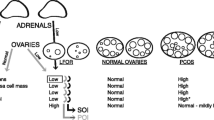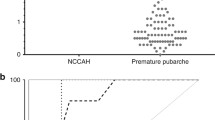Abstract
It has been recently reported that many hirsute women are affected with functional ovarian hyperandrogenism (FOH) - a term that encompasses the heterogeneous polycystic ovary syndrome - and show an abnormal ovarian steroidogenic response to gonadotropin-releasing hormone (Gn-RH) agonists. The aims of the present study were to determine the prevalence of FOH by the assessment of 17-hydroxyprogesterone (17-OHP) response to the Gn-RH agonist buserelin, to correlate these abnormal responses to other parameters suggestive of PCOS, and to assess the possible adrenal origin of hyperandrogenism. Therefore, in 33 consecutive women with hirsutism serum LH, FSH, 17-OHP, dehydroepiandrosterone sulfate (DHEA-S), androstenedione (A), Cortisol levels were evaluated in basal conditions and after the administration of buserelin (0.5 mg sc) and ACTH (tetracosactide 0.25 mg iv). Two patients were affected with a non classic congenital adrenal hyperplasia (CAH) -21OH deficiency. In 5 other women ACTH test caused a rate increase 17-OHP (30-0)/30 min >19 nmol/L/min (0.25±0.03; mean ± SE), suggesting the possible existence of heterozygote non classic CAH-21OH. One patient showed a DHEA-S response to ACTH (from 10.3 to 17.2 μmol/L), which was compatible with late-onset 3ß-Hydroxy-Δ5steroid dehydrogenase deficiency. Out of the 25 patients with normal responsiveness to ACTH, 11 women (group A) showed higher 17-OHP and A levels, in comparison to normal women, both in basal conditions (17-OHP= 4.18±0.72 vs 1.74±0.34 nmol/L, p<0.005; A=11.8±1.2 vs 6.0±0.7 nmol/L, p<0.05) and after buserelin (17-OHP= 15.61±1.31 vs 6.96±0.9 nmol/L; A=19.0±1.9 vs 7.5±0.8 nmol/L; p<0.001). In 6 of these 11 patients basal and buserelin-stimulated LH levels were higher than in normals. The remaining 14 patients (group B) showed normal baseline and buserelin-stimulated 17-OHP and A concentrations. In this group only 2 patients had high basal and stimulated LH levels. An augmented LH/FSH ratio was present in 5 and 1 cases of groups A and B, and polycystic ovaries at ultrasonography were observed in 7 and 8 cases of groups A and B, respectively. It is to note that an abnormal 17-OHP response to buserelin was present also in 3 of the 5 patients with abnormal 17-OHP rise after ACTH test, suggesting an adrenal and ovarian cause of hyperandrogenism. In conclusion, an abnormal response to one or both stimulation test was present in 57% of cases: an adrenal origin of hirsutism was detected in 15%, a combined adrenal and ovarian origin was found in 9% and an ovarian cause was present in 33%. Buserelin testing is an useful means to reveal the presence of FOH.
Similar content being viewed by others
References
Barnes R.B., Rosenfield R.L., Burstein S., Ehrmann D.A. Pituitary-ovarian responses to nafarelin testing in the polycystic ovary syndrome. N. Engl. J. Med. 320: 559, 1989.
Ehrmann D.A., Rosenfield R.L., Barnes R.B., Brigell D.F., Sheik Z. Detection of functional hyperandrogenism in women with androgen excess. N. Engl. J. Med. 327: 157, 1992.
Ehrmann D.A., Barnes R.B., Rosenfield R.L. Polycystic ovary syndrome as a form of functional ovarian hyperandrogenism due to dysregulation of androgen secretion. Endocr. Rev. 16: 322, 1995.
Ibanez L., Potau N., Zampolli M., Prat N., Gussinye M., Saenger P., Vicens-Calvet E., Carrascosa A. Source localization of androgen excess in adolescent girls. J. Clin. Endocrinol. Metab. 79: 1778, 1994.
Sahin Y., Kelestimur F. 17-Hydroxyprogesterone response to buserelin testing in the polycystic ovary syndrome. Clin. Endocrinol. (Oxf) 39: 151, 1993.
White D., Leigh A., Wilson C., Donaldson A., Franks S. Gonadotrophin and gonadal steroid response to a single dose of a long-acting agonist of gonadotrophin-releasing hormone in ovulatory and anovulatory women with polycystic ovary syndrome. Clin. Endocrinol. (Oxf) 42: 475, 1995.
Ferriman D., Gallwey J.D. Clinical assessment of body hair growth in women. J. Clin. Endocrinol. Metab. 721: 1440, 1961.
Lee P.A., Rosenwarks Z., Urban M.D., Migeon C.J., Bias W.D. Attenuated forms of congenital adrenal hyperplasia due to 21-hydroxylase deficiency. J. Clin. Endocrinol. Metab. 55: 866, 1982.
Siegel S.F., Finegold D.N., Lanes R., Lee P.A. ACTH stimulation tests and plasma dehydroepiandrosterone sulfate levels in women with hirsutism. N. Engl. J. Med. 323: 849, 1990.
Eldar-Geva T., Hurwitz A., Vecsei P., Palti Z., Milwidsky A., Rosier A. Secondary biosynthetic defects in women with late-onset congenital adrenal hyperplasia. N. Engl. J. Med. 323: 855, 1990.
McLaughlin B., Barrett P., Finch T., Devlin J.G. Late onset adrenal hyperplasia in a group of Irish females who presented with hirsutism, irregular menses and/or cystic acne. Clin. Endocrinol. (Oxf) 32: 57, 1990.
Turner E.I., Watson M.J., Perry L.A., White M.C. Investigation of adrenal function in women with oligomenorrhoea and hirsutism (clinical PCOS) from the North-East of England using an adrenal stimulation test. Clin. Endocrinol. (Oxf) 36: 389, 1992.
Barnes R.B., Ehrmann D.A., Brigell D.F., Rosenfield R.L. Ovarian steroidogenic responses to Gonadotropin-Releasing Hormone agonist testing with nafarelin in hirsute women with adrenal responses to adrenocorticotropin suggestive of 3ß hydroxy-Δ5-steroid dehydrogenase deficiency. J. Clin. Endocrinol. Metab. 76: 450, 1993.
Gilling-Smith C., Willis B.S., Beard R.W., Franks S. Hypersecretion of androstenedione by isolated thecal cell from polycystic ovaries. J. Clin. Endocrinol. Metab. 79: 1158, 1994.
Rosenfield R.L., Barnes R.B., Ehrmann D.A. Studies of the nature of 17-hydroxyprogesterone hyperresponsiveness to gonadotropin-releasing hormone agonist challenge in functional ovarian hyperandrogenism. J. Clin. Endocrinol. Metab. 79: 1686, 1994.
Lachelin G.C., Barnett M., Hopper B.R., Brink G., Yen S.C. Adrenal function in normal women and women with the polycystic ovary syndrome. J. Clin. Endocrinol. Metab. 49: 892, 1979.
Loughlin T., Cunningham S., Moore A., Culliton M., Smith P.P.A., McKenna T.J. Adrenal abnormalities in polycystic ovary syndrome. J. Clin. Endocrinol. Metab. 62: 142, 1986.
Robinson S., Deacon A., Wheeler M.J., Clayton R.N. Which hormone tests for the diagnosis of polycystic ovarian syndrome? Br. J. Obstet. Gynaecol. 99: 232, 1992.
Wilke T.J., Utley D.J. Total testosterone, free androgen index, calculated free testosterone, and free testosterone by analog RIA compared in hirsute women and in otherwise normal women with altered binding of sex-hormone binding globulin. Clin. Chem. 33: 1372, 1987.
Selby C. Sex hormone binding globulin: origin, function and clinical significance. Ann. Clin. Biochem. 27: 532, 1990.
Ardaens J., Poison D.W., Franks S. Polycystic ovarian disease: contribution of vaginal endosonography and reassessment of ultrasonic diagnosis. Fertil. Steril. 55: 1062, 1991.
Poison D.W., Adams J., Franks S. Polycystic ovaries — a common finding in normal women. Lancet 1: 870, 1988.
Carmina E., Wong L.L., Thornton M.H., Stanczyk F.Z., Paulson R.J., Sauer M.V., Lobo R.A. Androgen profiles of ovulatory women with polycystic appearing ovaries and alteration in serum IGF-BP 1. The Endocrine Society, 77th Annual Meeting, Washington, June 1995, OR31-5 (abs), 1995.
Hatch R., Rosenfield R.L., Kim M.H., Tredway D. Hirsutism: implications, etiology, and management. Am. J. Obstet. Gynecol. 140: 815, 1981.
Barnes R., Rosenfield R.L. The polycystic ovary syndrome: pathogenesis and treatment. Ann. Intern. Med. 110: 386, 1989.
Author information
Authors and Affiliations
Rights and permissions
About this article
Cite this article
Ambrosi, B., Re, T., Passini, E. et al. Value of buserelin testing in the evaluation of hirsute women. J Endocrinol Invest 19, 204–209 (1996). https://doi.org/10.1007/BF03349868
Accepted:
Published:
Issue Date:
DOI: https://doi.org/10.1007/BF03349868




